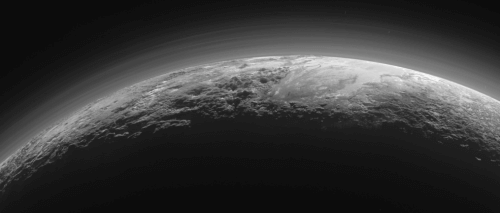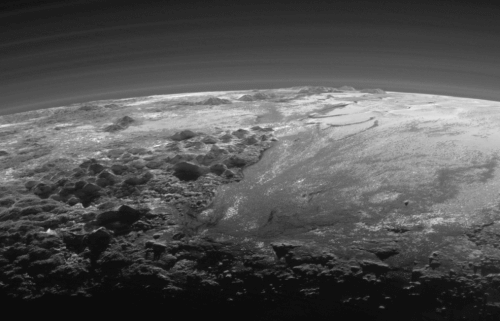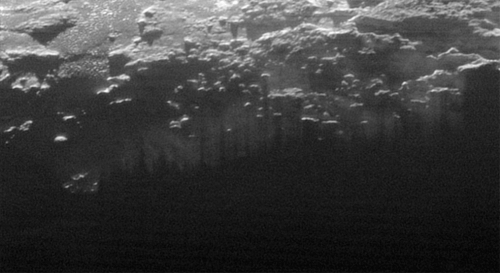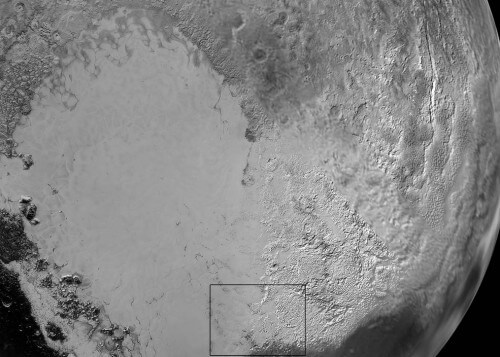Among other things, photos that arrived last week reveal a "hydrological" cycle in which nitrogen replaces water, and fog that covers the low-lying areas, rising up to a height of 100 kilometers

The New Horizons spacecraft has already moved away from Pluto, and in recent months scientists have been downloading and deciphering the images stored in its computers. One image that was deciphered this week amazed the scientists, not only did it provide a breathtaking view of the majestic icebergs, streams of frozen nitrogen and eternal haze in the low places but also shows that there is a similarity between Pluto and the polar regions of the Earth.
The mountains of Pluto, the frozen and hazy plains
Pluto's majestic mountains, icy plains and misty haze as photographed just 15 minutes after New Horizons' closest point to Pluto on July 14, 2015. New Horizons looked back toward the Sun and captured a sunset image of the jagged icebergs and ice plains that extend to the horizon The smooth expanse of the so-called Sputnik Plain (right) is flanked to the west (left) by mountains up to 3,500 meters high, including the Norwegian Norgay Monte in the foreground and the Hillary Montes on the horizon.
To the right, east of Sputnik, the plain is cut by what appear to be glaciers, the sunlight illuminating the area from behind highlights over a dozen layers of haze in the thin but inflated atmosphere. The photo was taken from a distance of about 18 thousand kilometers and the width of the photographed area is 1,250 kilometers.

The image of Pluto as a moon was captured by the Ralph Multispectral Camera on July 14 and transmitted to Earth on September 13, and provides a high-angle view of the Plutonian landscape backlit by the Sun. The width of the area visible in the picture is 1,250 km.
"These images make us feel like we're there on Pluto and scanning the terrain ourselves," says New Horizons principal investigator Alan Stern of the Southwest Research Institute in Boulder, Colorado. But this image is a scientific bonanza, and it reveals details about the atmosphere, the mountains, the glaciers and the plains.
The fog or haze near the ground of Pluto. In this image derived from the image of the crescent moon, you can see Pluto illuminated by the light of the setting sun. In this lighting you see the fog near the ground cut by parallel shadows of local hills and small mountains. The photo was taken from a distance of 18 kilometers and the width of the section photographed in it is 185 kilometers.

"In addition to being visually stunning, this low-lying haze suggests that the weather changes from day to day on Pluto, just like it does here on Earth," said Will Grundy, New Horizons team leader at the Wellwell Observatory in Flagstaff, Arizona.
Combined with previous images, this new image also provides evidence for the existence of a "hydrological" orbit on Pluto - striking in its resemblance to Earth, but composed of exotic mixtures that include nitrogen rather than water ice.

The bright areas to the east of the Sputnik Plain were already covered by these nebulae that evaporated from the surface of the Sputnik Plain and then sank to the east. The thermal panoramic image of the new Ralph camera also reveals glaciers flowing back to the Sputnik Plain from the blanketed hills. These features are similar to the frozen currents at the edges of the ice caps in Greenland and Antarctica.
More of the topic in Hayadan:

3 תגובות
The cameras on the probe are not mobile phone cameras with an option to change shades and a selfie lens.
These are expensive CCD lenses and sensors whose primary purpose is to survive in vacuum conditions, intense radiation and extreme temperature changes for years.
Adding color rendering capability to entertain the masses is unnecessary. (Especially when the photos can simply be colored when they reach us). Colorless photography allows for higher resolution.
Finally, most images are captured by cameras that are sensitive to wavelengths that are invisible to the human eye. When these images are translated into visible light, color has no meaning.
Why are the pictures in black and white? There is no color on this planet?